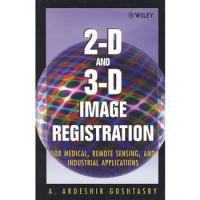| 定价: | ¥ 854 | ||
| 作者: | A. Ardeshir Goshtasby 著 | ||
| 出版: | 吉林长白山 | ||
| 书号: | 9780471649540 | ||
| 语言: | 英文原版 | ||
| 日期: | 2005-03-01 | ||
| 版次: | 1 | 页数: | 258 |
| 开本: | 16开 | 查看: | 0次 |

| 服务商城 | 客服电话 | 配送服务 | 优惠价 | 购买 |
| 400-711-6699 | 满29至69元,免运费! | ¥751.5 |
To master the fundamentals of image registration, there is no more comprehensive source than 2-D and 3-D Image Registration. In addition to delving into the relevant theories of image registration, the author presents their underlying algorithms. You'll also discover cutting-edge techniques to use in remote sensing, industrial, and medical applications. Examples of image registration are presented throughout, and the companion Web site contains all the images used in the book and provides links to software and algorithms discussed in the text, allowing you to reproduce the results in the text and develop images for your own research needs. 2-D and 3-D Image Registration serves as an excellent textbook for classes in image registration as well as an invaluable working resource.
作者简介:
A. ARDESHIR GOSHTASBY, PHD, is a professor in the department of computer science and engineering at Wright State University. Dr. Goshtasby has been developing solutions to image registration problems since 1983 and has numerous publications to his credit.
作者简介:
A. ARDESHIR GOSHTASBY, PHD, is a professor in the department of computer science and engineering at Wright State University. Dr. Goshtasby has been developing solutions to image registration problems since 1983 and has numerous publications to his credit.
Preface
Acknowledgments
Acronyms
1 Introduction
1.1 Terminologies
1.2 Steps in Image Registration
1.3 Summary of the Chapters to Follow
1.4 Bibliographical Remarks
2 Preprocessing
2.1 Image Enhancement
2.1.1 Image smoothing
2.1.2 Deblurring
2.2 Image Segmentation
2.2.1 Intensity thresholding
2.2.2 Boundary detection
2.3 Summary
2.4 Bibliographical Remarks
3 Feature Selection
3.1 Points
3.2 Lines
3.2.1 Line detection using the Hough transform
3.2.2 Least-squares line fitting
3.2.3 Line detection using image gradients
3.3 Regions
3.4 Templates
3.5 Summary
3.6 Bibliographical Remarks
4 Feature Correspondence
4.1 Point Pattern Matching
4.1.1 Matching using scene coherence
4.1.2 Matching using clustering
4.1.3 Matching using invariance
4.2 Line Matching
4.3 Region Matching
4.3.1 Shape matching
4.3.2 Region matching by relaxation labeling
4.4 Chamfer Matching
4.4.1 Distance transform
4.5 Template Matching
4.5.1 Similarity measures
4.5.2 Gaussian-weighted templates
4.5.3 Template size
4.5.4 Coarse-to-fine methods
4.6 Summary
4.7 Bibliographical Remarks
5 Transformation Functions
5.1 Similarity Transformation
……
6 Resampling
7 Performance Evaluation
8 Image Fusion
9 Image Mosaicking
10 Stereo Depth perception
Glossary
References
Index
Acknowledgments
Acronyms
1 Introduction
1.1 Terminologies
1.2 Steps in Image Registration
1.3 Summary of the Chapters to Follow
1.4 Bibliographical Remarks
2 Preprocessing
2.1 Image Enhancement
2.1.1 Image smoothing
2.1.2 Deblurring
2.2 Image Segmentation
2.2.1 Intensity thresholding
2.2.2 Boundary detection
2.3 Summary
2.4 Bibliographical Remarks
3 Feature Selection
3.1 Points
3.2 Lines
3.2.1 Line detection using the Hough transform
3.2.2 Least-squares line fitting
3.2.3 Line detection using image gradients
3.3 Regions
3.4 Templates
3.5 Summary
3.6 Bibliographical Remarks
4 Feature Correspondence
4.1 Point Pattern Matching
4.1.1 Matching using scene coherence
4.1.2 Matching using clustering
4.1.3 Matching using invariance
4.2 Line Matching
4.3 Region Matching
4.3.1 Shape matching
4.3.2 Region matching by relaxation labeling
4.4 Chamfer Matching
4.4.1 Distance transform
4.5 Template Matching
4.5.1 Similarity measures
4.5.2 Gaussian-weighted templates
4.5.3 Template size
4.5.4 Coarse-to-fine methods
4.6 Summary
4.7 Bibliographical Remarks
5 Transformation Functions
5.1 Similarity Transformation
……
6 Resampling
7 Performance Evaluation
8 Image Fusion
9 Image Mosaicking
10 Stereo Depth perception
Glossary
References
Index





 粤公网安备 44030902003195号
粤公网安备 44030902003195号